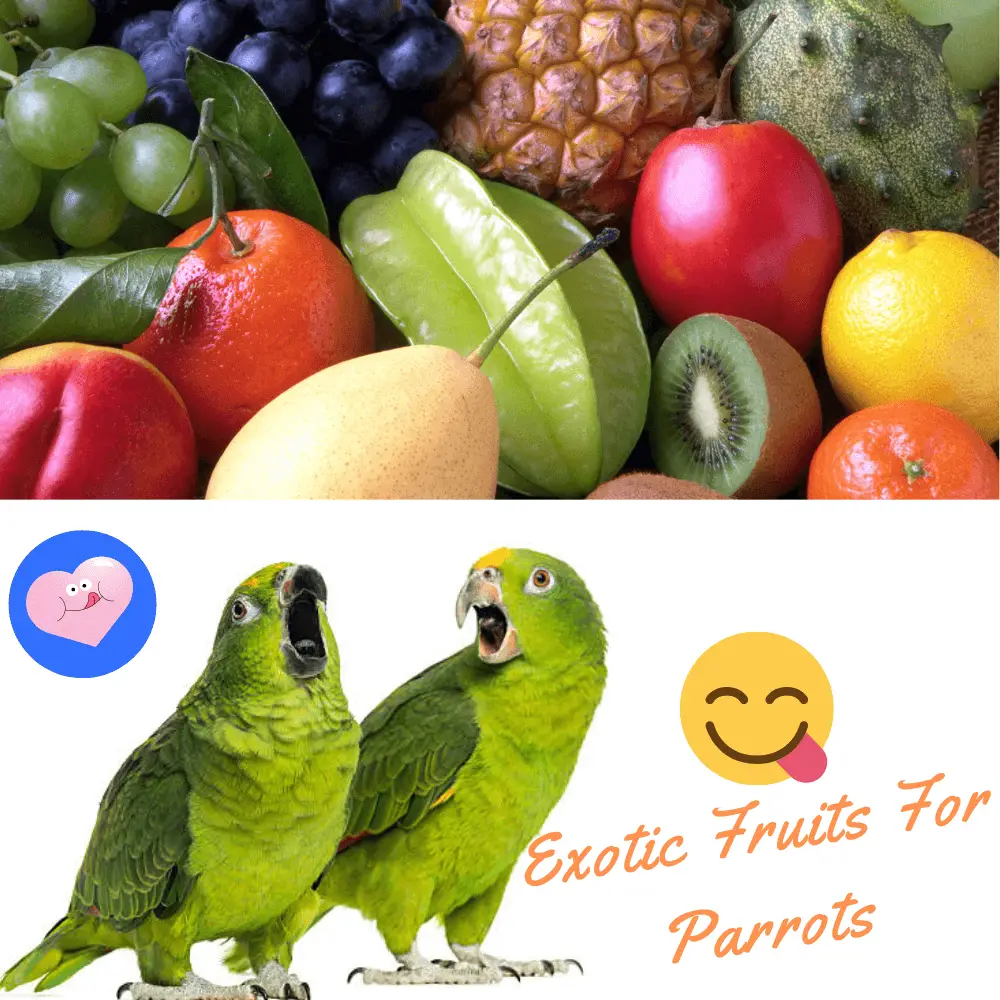
Food: fresh fruit allowed for our parrots,Our parrots must consume fresh food daily to obtain all the nutrients necessary to maintain good health.
We will give you here the list of fruits that they can consume without danger, with the exception of autumn berries , which you will find in another subject. This is valid for all Psittacidae, from the smallest to the largest. Seeds and pits should always be removed, as they contain cyanide and are therefore toxic to our birds.
The skin must also be washed, even removed for more safety, especially concerning exotic fruits, which can carry more parasites and bacteria which are more difficult to eradicate.
- apricot
- pineapple
- anone
- arbouse
- goji bath
- mountain ash berry
- banana
- brugnon
- cranberry
- carom
- cherry
- chayote (chayote)
- clementine
- cranberry
- cristophine
- fig
- prickly pear
- strawberry
- chinese strawberry
- wild strawberry
- raspberry
- passion fruit
- yellow passion fruit
- goji
- grenade
- yellow grenadilla
- currant
- jujube
- feet
- apple khaki
- kiwano
- green kiwi
- yellow kiwi
- kumquat
- litchi
- hairy lychee
- mandarin
- mangosteen
- mango
- melon
- blackberry
- blueberry
- nashi
- yellow nectarine
- medlar
- coconut
- orange
- grapefruit (in small quantities)
- papaya
- yellow watermelon
- red watermelon
- sin
- yellow pitaya
- pitaya rose
- red pitaya
- pear cut down
- comice pear
- yellow Williams pear
- red Williams pear
- pomelo (in small quantities)
- apple
- yellow plum
- red plum
- White grapes
- black Grappe
- pink grape
- rambutan
- salak (or snake fruit)
- red tamarillo
- tamarind
- tangerine.
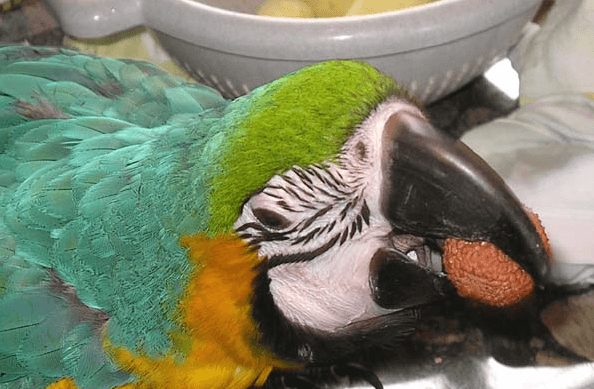
Exotic fruits for parrots
This list will be enriched with varieties tested by our own psittacidae, remember to come back and consult it. In addition to the topics already written by us concerning these different fruits and their success with our birds, you can judge their caloric intake HERE , in order to assess the right quantity to dispense. Also see our articles on fresh vegetables that can be offered safely to your parrots as well as toxic foods for them .
Plantain
- Its green skin is thicker than that of a banana, and its flesh is firmer and less sweet. This skin turns yellow and then blackens as the fruit ripens.
- The plantain is not edible raw, even ripe. Its starch, which is different from that of bananas, turns into sugar as the plantain becomes ripe, but not enough for the fruit to be pleasant to eat raw. Ripe plantains, however, can be cooked as fruit.
- Plantains can be cooked whole or sliced. It retains its shape when cooked. It is cooked in water ( about 25 min ) or on the grill ( about 45 min at 10 cm from the heat source ). It is very often fried. You can cook it in the oven without peeling it ( wash the skin well ); count about an hour at 180 ° C / 350 ° F. You can also cut both ends and remove the skin, or simply cut the skin along its entire length.
- The plantain differs from the sweet banana. It is a cooking banana that is eaten more like a vegetable, while the sweet banana is a fruit almost always tasted raw. Moreover, their compositions are also found to be quite distant from each other, even if both plantains and sweet bananas appear to be richer in carbohydrates and more energy than other fresh fruits.
Exotic fruits for parrots
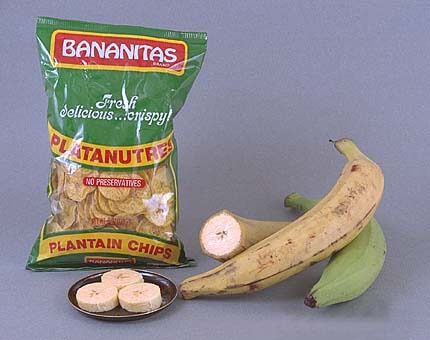
- The minerals in plantains are varied and their contents close to those of sweet bananas: potassium dominates ( 350 mg ), followed by phosphorus ( 35 mg ), magnesium ( 33 mg ) and calcium ( 7 mg ).
- The more green marks the banana has, the less ripe it is and the longer it will keep.
- On the other hand, it will have to be left to ripen before offering it raw, because at this stage, it is indigestible. It is ready to eat when the flesh gives way slightly to the pressure and the peel is quite yellow and slightly striped, without any green coloring. When it shows brown or black spots, it is past this stage and is then better suited for cooking. Note that small bananas are known to be sweeter than large ones.
- Plantains are usually sold when their skin is green.
- Plantains peel more easily after they have been blanched for five minutes in boiling salted water.
- As the banana turns black on contact with the cold, it is recommended to store it at room temperature, in a fruit bowl or on the counter. To hasten ripening green bananas, place them in a brown paper bag.
- To freeze plantains, remove the skin and freeze whole, chopped or mashed; sprinkle with lemon juice from the freezer to prevent it from oxidizing.
Carambola
- The fruit should be firm and the skin smooth and shiny. A green fruit is a sign of immaturity. Choose a firm fruit, well colored, free from bruises and which gives off a fruity aroma.
- When fully ripe, the yellow skin turns slightly golden and the tips begin to brown. There are two varieties of star fruit: the sweet varieties and the sour varieties. Unfortunately, it is very difficult to differentiate them visually, and the variety is rarely indicated in supermarkets.
- Starfruit seems fragile, but it stores easily. Leave it at room temperature if you intend to consume it in the days to come or if it is not ripe enough. Refrigerate it for longer storage, which can exceed 15 days if the fruit is in good condition.
- Starfruit may or may not be peeled. We can prepare it as we wish: cubed, diced, chopped or mashed. The star fruit is often sliced crosswise. Cut in this way, the slices take the shape of a small star, hence the origin of its English name: starfruit.
- Starfruit is often sliced and eaten plain. You can turn starfruit into sorbet or jelly. Its juice is also very refreshing.
Exotic fruits for parrots
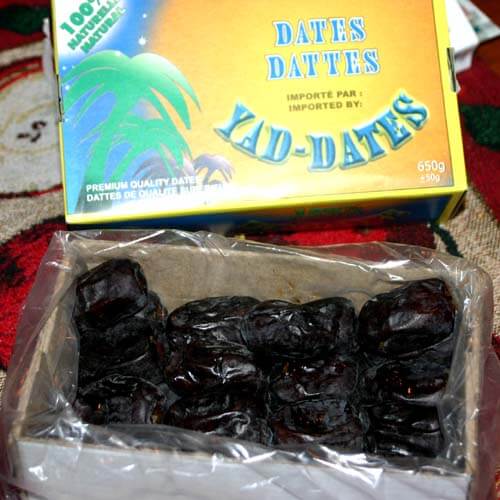
The date
- Fruit of a variety of palm spread throughout the Mediterranean basin, the date has an original composition which clearly differentiates it from other fruits and explains why it is commonly presented in the form of a dried date.
- The fresh date is not very common on the market: it is a fragile fruit of limited conservation.
- The date is mainly marketed and consumed in the form of a dry date, that is to say, partially dehydrated. It is concentrated, which causes significant changes in its composition and gives it very specific nutritional characteristics. ( See text on dehydrated fruits ).

The FIG
- The fig is not a real fruit, but rather a receptacle. The multiple seeds contained within constitute the actual fruits.
- Look for plump, rather soft, slightly wrinkled fresh figs. Avoid those with bruised skin. The black fig, the green fig and the purple fig are the three main varieties currently on the market. The purple fig is the sweetest and juiciest of the three, while the black fig is rather dry.
- For dried figs, the fruits should be moist and compact, without being too hard.
- Fresh figs do not keep for long. Stored in the refrigerator, they should be consumed within 2 days of purchase. Being very fragile, they must be handled with care and kept away from foods with a strong smell, as they could soak up.
- Dried figs can be stored much longer. Just store them in a cool place away from moisture.
- Figs should be washed gently in cold water before eating. It is possible to peel them, but it is not necessary. The fruit is eaten whole.

Prickly pear
- This small ovoid-shaped fruit, measuring 5 to 8 cm in length, is easily identifiable thanks to the thin thorns that cover its green and fairly thick skin. The fruit is eaten peeled, and its pulp, coral or red in color, appears full of small dark seeds that can be eaten.
- The prickly pear is thus presented as a moderately energetic fruit, being at the same level as orange or blueberry.
- Highest fiber content for fresh fruit, around 4.4 to 5 g per 100 g. The vast majority of these are insoluble fibers ( cellulose, hemicelluloses, lignin ), in particular forming the web of the small seeds present in the pulp.

Exotic fruits for parrots
- The prickly pear contains provitamin A ( in the form of beta-carotene and cryptoxanthin ), at a rate of 45 to 60 micrograms per 100 g. Among the minerals, we observe, in addition to a predominance of potassium ( usual in fresh plants) , particularly high levels of calcium ( 46 mg per 100 g ) and magnesium ( 28 mg ): they are among the highest for a fruit. fresh. Since the phosphorus does not exceed 32 mg, this results in a calcium / phosphorus ratio very clearly greater than 1, which promotes good calcium assimilation.
- Most of the fruits have been stripped of their thorns before being offered for sale. If not, handle them with care. Choose prickly pears that are intact, not shriveled and without spots.
- Let the prickly pear ripen at room temperature. Eat it as soon as it is ripe or place it in the refrigerator, it will keep for a few days only.
- The prickly pear is imported in autumn from Spain and Sicily, but also from Colombia and South Africa.
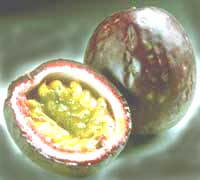
Passion fruit
- Choose a wrinkled fruit, free of bruises and as heavy as possible. If the skin of the Passion fruit is smooth, it is because it is not ripe. The shell of a passion fruit that has not reached its point of maturity is hard and leathery. It is also smooth and shiny. At this stage, the fruit is not very tasty and the pulp very acidic.
- Choose a fruit whose shell gives way under a light pressure of the finger. Favor fragrant and heavy fruits for their size. The hulls of passion fruit found in our supermarkets are usually yellow, purple or orange in color. Its flesh can present various shades including green, pink, yellow or orange and sometimes even be whitish.
- Passion fruit keeps relatively well due to its thick skin which protects it and keeps its very juicy flesh. If the skin of the fruit is not crumpled enough, let it ripen at room temperature.
- Once it is fully ripe, it will keep for up to a week in the refrigerator. It is also possible to freeze it. Whole, wrap in a freezer bag or keep only the flesh wrapped tightly.
- You have to cut the fruit in half and remove the flesh, the skin is not edible.
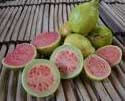
Guava
- Look for a smooth guava that’s not bruised, neither too soft nor too hard. An overripe fruit has an unappealing odor, while an unripe fruit is inedible because it is astringent.
- The guava is chosen by testing its skin ( green tinting yellow when ripe ) which must give way under a very light pressure of the finger.
- Leave the guava at room temperature until ripe. To speed up the process, place it in a paper bag. Do not refrigerate it until it is ripe, as this will stop ripening.
- It will keep for a few days in the refrigerator.
- Guava is an exceptional source of vitamin C: its content exceeds 240 mg, one of the highest in fruits.
- Guava is a fruit with little sugar content.
- Pectins are abundant: these soluble fibers give the pulp its slightly gelatinous consistency.
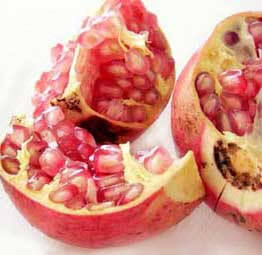
The grenade
- Choose a pomegranate of large size, colorful, partially tinted brown, heavy and free of blemishes.
- Leave wrinkled fruit with dull or discolored skin.
- The pomegranate is a round fruit, about the size of a small orange, and covered by a thick firm and shiny skin, dark red when ripe. When we cut the pomegranate in half, we discover a multitude of dark seeds, arranged in “boxes” delimited by thick partitions.
- Fruits are usually picked between the fifth and seventh months after flowering. They no longer ripen after picking and are therefore harvested when ripe.
- Leave the pomegranate at room temperature for a few days or place it in the refrigerator if it is not to be consumed immediately. It will keep for about three weeks. Pomegranate freezes easily by removing the seeds and freezing it as is.
- Parrots love it.
- The juice of the fruit stains a lot… red speckled cockatoo!

Khaki
- A remarkable source of provitamin A, so precious for our birds.
- It is, along with mango, melon and apricot, one of the fruits richest in provitamin A.
- Persimmon should be eaten when very ripe, that is, completely soft. If it is not ripe, it is astringent and inedible. Green or yellow before being ripe, it turns vermilion red as it ripens.
- Persimmon should be eaten raw, which best preserves its vitamin and mineral richness.
- The color of this fruit has nothing to do with its name. The flamboyant coloring of his skin and flesh bears no resemblance to military uniforms. Persimmon, rounded in shape and capped with leaves, strangely resembles tomato.
- Hakiya khaki is at its best when it looks faded. Thus, a fruit with a slightly dull skin and soft flesh will be juicy, sweet and very fragrant. Still firm, the fruit is inedible. This is due to the significant presence of tannins which decrease throughout the ripening of the fruit.
- Fuyu persimmon, on the other hand, can be eaten when it is still firm, since its flesh does not contain tannins. It can be eaten like an apple. This fruit is very round and has an orange-yellow color.
- Persimmons are available in fruit stores, delicatessens and some supermarkets. They are sold fresh, dehydrated or canned.
- Learn about the variety and do not rely on the color, which is not a sign of ripening, as khaki is generally very colorful. However, yellow or greenish persimmons should be avoided. Choose intact specimens.
- Fuyu persimmon will keep for about 2 weeks in the refrigerator.
- Leave the hachiya persimmon in the air if it is to continue to ripen. To speed up the process, place the fruit in a paper bag; to activate it even more, add fruits which give off ethylene, such as bananas or apples. Once ripe, it will keep in the refrigerator for about 2 days.
- You can also freeze persimmons whole, in pieces or mashed. If they are not whole, add a little lemon juice to preserve their beautiful bright color.
- To peel it, a one or two hour stay in the refrigerator gives it more firmness and facilitates the operation.

The kiwi
- Generally, we choose a kiwi that gives way under a light pressure of the finger. However, it’s all about taste. If you prefer tangy flesh that holds together well ( for decoration, for example ), choose a firmer kiwi. On the other hand, if you prefer a sweet and tender flesh, choose a softer kiwi.
- The skin of the kiwifruit should be tight, fluffy, intact, and free from blemishes. Move aside any that are soft or damaged. Commercial fruits are generally firmer because they are picked before they are fully ripe. The size of the fruit does not affect its quality.
- Recently, a variety of yellow-fleshed kiwi has been found in large grocery stores.
- Kiwifruit can be stored for a few days at room temperature. It will then continue to mature. You can also place it in the refrigerator to slow down its ripening. It will keep for about a week.
- It is not recommended to freeze the kiwi, as its texture will be greatly affected.
- The kiwi may or may not be peeled. This is because the skin of the kiwi is edible, but most people prefer to peel the fruit before consuming it.
- It is important to note that fresh kiwi fruit cannot be incorporated into fruit gelatins. Indeed, the kiwi has enzymes which “digest” proteins. Since gelatin is a protein, it is therefore destroyed by the enzymes of the kiwi which then prevent it from freezing.
- The firm fruit will keep for several weeks in the refrigerator or a few weeks at room temperature.

The kumquat
- The kumquat is the smallest of the citrus family. It is 2 to 5 cm ( 3/4 to 2 in ) long.
- It has been crossed with several fruits, including lime ( limequat ), orange ( orangequat ), lemon ( lemonquat ) and tangerine ( calamondin ).
- It can be found on the shelves of our supermarkets from December to May.
- Choose firm, shiny-skinned kumquats without spots or bruises. Discard soft kumquats, as they deteriorate quickly.
- Kumquats are sometimes sold still attached to their branches, which have been left with some very decorative small green leaves ( do not offer these leaves to the bird ).
- Kumquats deteriorate quickly at room temperature. Place it in the fridge: in the refrigerator, you will keep it for up to 3 weeks.
- Since the rind is edible, wash the kumquat thoroughly in warm soapy water. Then rinse it thoroughly under cold water before offering it.
- Sometimes fresh kumquat is tough. Blanch it for a few seconds in boiling water before eating it. Kumquat has a fairly pronounced bitter flavor.
Exotic fruits for parrots
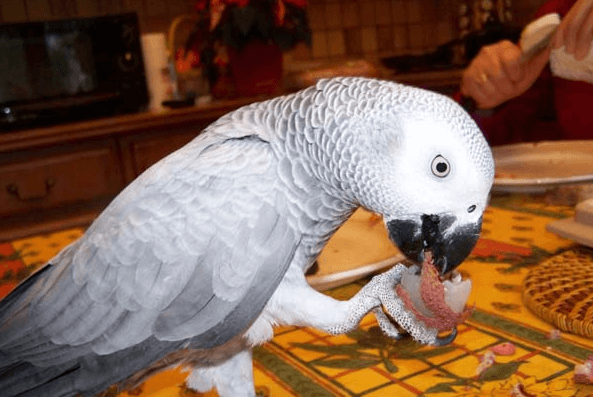
Lychee
- This fruit is considered the most exquisite there is. It is sometimes called “Chinese cherry” since its culture originates from this country.
- Lychee no longer ripens after picking, rather poorly withstands transport and time to market, which is why it is so often brownish and not very tasty in Western markets.
- The shell of lychee is thin and rough. It must be a beautiful bright red. The translucent flesh is a milky white, slightly pinkish. A brown shell and greyish flesh are signs of aging. Choose fruits that are intact, free from cracking and colored.
- Lychees freeze as they are in their shell.

- Lychees are bought fresh or canned in syrup, and sometimes dried, candied or in bunches.
- Lychees will keep for about a week in the refrigerator. Store fresh, unpeeled lychees in a perforated plastic bag. Insert a sheet of absorbent paper to prevent excess moisture. Lychees should be eaten quickly, as they tend to ferment.
- You can also freeze your lychees. It is better to pit them and remove the shell. Serve them partially thawed during the summer season.
- Before consuming fresh lychees, you must remove the shell covering them. It peels off easily with your fingers. Only the flesh of the fruit should be eaten, as the core in the center is inedible.

The mango
- Mango is available most of the year, but it is from May to September that it is found in abundance.
- Choose a firm mango with smooth skin and no bruises. The color of the skin varies depending on the variety of mango. It is not a sign of maturity or of the quality of the fruit.
- Mangoes continue to ripen once picked. Ripen the mango at room temperature for 3 to 5 days or until the flesh gives way under finger pressure. Then place it in the refrigerator until you are ready to eat it.
- To taste mango without any problem, you just need to know how to cut it! Here’s how to do it:
- The mango has a large oval-shaped core. Using a sharp knife, cut the flesh on each side of the latter, so as to obtain two halves of mango. Since the stone is not located in the center of the fruit, it is normal for the two parts to be unequal.
- Place the mango pieces skin side down. Cut the flesh horizontally then vertically, so as to form a grid. Do not cut the skin.
- Using both hands, then fold the skin outward. It is then easy to detach the mango cubes formed by the grid from the skin, using a sharp knife.
- Store imperfectly ripe fruit at room temperature. To accelerate their ripening, put them with an apple in a paper bag ( the apple will produce ethylene, a gas which has the effect of ripening the other fruits ).
- Refrigerator: only a few days, because the cold damages the mango.
- Freezer: peel, remove the core and slice the mango before putting it in the freezer. Or make a puree and pour into ice cube trays, freeze, put in sachets and return everything to the freezer.

Papaya
- Papaya, especially immature, contains an enzyme called “papain”. They are proteolytic enzymes, that is to say, which “digest” proteins, especially those found in meat. It is sometimes found on the market, sold as a tenderizing agent for meat.
- Ripe papayas have smooth skin that is pale yellow to orange-red in color. The fruit is perfectly ripe when the flesh gives way under a light pressure of the finger. If the skin of the papaya is green with yellow traces, you can buy it without any problem and let it ripen at room temperature. On the other hand, if the papaya has a totally green and hard skin, it means that the fruit was picked too early and that it will not ripen.
- Also reject very soft or very bruised papayas.
- The pulp of papaya is usually orange in color and the inside is filled with small, black edible seeds.
- A totally green papaya will not ripen. Leave it at room temperature if it needs to ripen. Place it in a paper bag if you want to speed up the process.
- Consume papaya as soon as it is ready. Avoid storing unripe papaya below 7 ° C or in the refrigerator, as it will no longer ripen. Ripe papaya will keep for a few days in the refrigerator.
- Freezing ripe papaya is not recommended.
- Cut the papaya in half lengthwise and remove the black seeds from the central cavity. Remove the flesh and discard the inedible peel.
- In fruit salads, papaya should only be added when ready to serve, as it may soften other fruits.
- It is not recommended to incorporate papaya into a fruit gelatin, as the papain may prevent the gelatin from setting.
- Papaya is sometimes eaten while it is still immature and its skin is green. At this point, it is more prepared like a vegetable. It is cooked much the same way as winter squash.
Parrots Eating Fruit
SOURCE:Parrot Wizard
Related Articles:




















